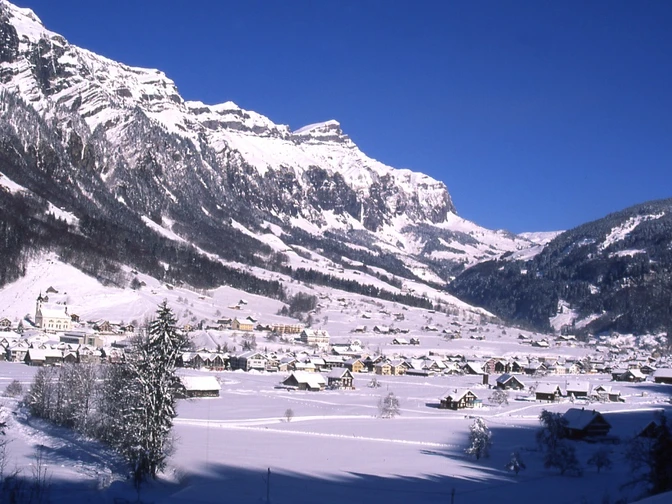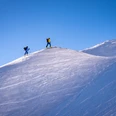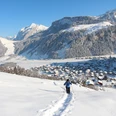- Photos & Map
How would you like to arrive?
- Description
- Good to know
- Nearby
- 2:45 h
- 10.94 km
- 680 m
- 1,798 m
- 608 m
- 2,402 m
- 1,794 m
- Start: Muotathal
- Destination: Husky-Lodge Muotathal
The Blüemberg offers a fantastic panoramic view. The descent into Muotathal is the longest pre-Alpine descent in Central Switzerland with 1800 meters of altitude.
Approach / Descent
A) Normal route from Lidernenhütte. Difficulty ZS
Ascent / Descent: 704m | Counter ascent on descent: 37m
Start altitude: 1728 m.a.s.l. | Finish altitude: 2402 m.a.s.l.
Time required ascent: 2¾ h | Distance: 4 km
Descent
B) to Muotathal. Difficulty ZS
descent: 1796m | counter ascent on descent: 11m
Start altitude: 2402 m.a.s.l. | Finish altitude: 607 m.a.s.l.
Time needed downhill: 2 h | Distance: 6.9 km
Places along the route: Rupperslauibödeli - Achslenteuffi - Wasserböden (Muotathal - SZ) - Ahöreli (Muotathal - SZ) - Riggis (Muotathal - SZ) - Hellweid (Muotathal - SZ)
Other possibilities (without track)
Downhill
C) to Chäppeliberg. Difficulty ZS
descent: 1246m | counter ascent on descent: 37m
Start altitude: 2402 m.a.s.l. | Finish altitude: 1193 m.a.s.l.
Time required downhill: 1½ h | Distance: 4.8 km
Places along the route: Alt Stafel (Riemenstalden - SZ) - Hochtännli - Stafel (Riemenstalden - SZ) - Berg (Riemenstalden - SZ)
Good to know
Best to visit
Directions
Equipment
Directions & Parking facilities
Additional information
Organization
Stoos-Muotatal Tourismus GmbH
Author´s Tip / Recommendation of the author
Safety guidelines
Ski touring routes are not marked and prepared. Access at your own risk. Please observe the following rules of conduct on the ski tour.
Healthy and fit in the mountains
Good fitness through regular endurance and weight training. Make sure you have reserves of strength for the descent.
Careful tour planning
Pay special attention to the weather forecast, as cold, wind and poor visibility increase the risk of accidents considerably. Plan alternative routes and checkpoints.
Complete equipment
Standard emergency equipment includes avalanche transceiver, shovel and probe, first aid kit, bivy sack, cell phone (Euro emergency 112) and an airbag system.
Avalanche situation report
Inform yourself in detail about the avalanche danger before the tour! What is the danger level, where are the danger spots, what are the current avalanche problems.
Weigh the avalanche risk
Base your decisions therefore on strategic methods of risk assessment (reduction methods) and pay attention to danger signs in the terrain.
Orientation and rest
It is important to master the use of map, altimeter, compass, app or GPS. Drinking, eating, and taking breaks are necessary to maintain performance and concentration.
Keep clearances
Clearances serve to relieve the snowpack and limit damage. Relief distances of 10 m when ascending steep slopes also increase comfort when making hairpin turns. When skiing downhill, always keep distances of at least 30 m and ski very steep slopes individually.
Avoid falls
Falls on the descent are the most frequent cause of accidents on ski tours. For the snow surface they mean a large additional load.
Small groups
Small groups (up to 6 people) increase safety. Communication with other winter sports enthusiasts and mutual consideration prevent dangerous situations.
Respect for nature and environment
Be considerate of wildlife, respect protected areas and do not enter reforested areas. To get there, carpool or use public transportation.
Nearby










